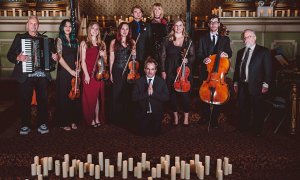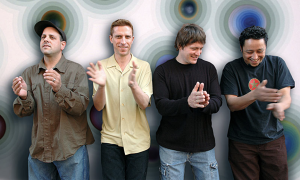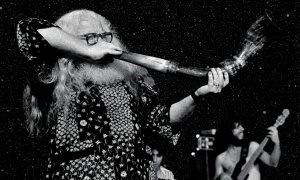Home » Jazz Articles » From the Inside Out » Three Pairs of Aces - Wild!
Three Pairs of Aces - Wild!
 Corina Bartra & Her Azu Project
Corina Bartra & Her Azu Project Afro Peruvian Jazz Celebration
Blue Spiral Music
2009
Corina Bartra does more than compose and sing in a style that merges music from North and South America—she lives this style by splitting her days between her native Peru and adopted hometown of New York City. Celebration, her fifth release, blends traditional Afro-Peruvian music with contemporary vocal and instrumental jazz, a fusion brought to life by her band of all-stars from both Peru and NYC. You cannot tell which passages are composed and which are improvised. Neither can you tell, except for the obvious folk songs, the Afro-Peruvian parts from the jazz parts. It's mostly one sprawling, ambitious, joyful Celebration.
Bartra's original "You Took Me By Surprise" exemplifies her cultural cocktail: it's full of surprising twists and turns based in the rhythmic innovations of be-bop. This is especially true in its central passage, where Bartra opens the melodic window and encourages saxophonist Xavier Perez to sail up and away; yet this rhythm continually flows thick and hot in the lusty spirit of Latin music. The moody and blue "Puente de los Suspiros" radiates a different fusion mood by synthesizing Latin rhythm and breathy, Stan Getz-like jazz saxophone.
Bandleader Bartra also remembers to honor traditional native music. The Afro-Peruvian folk song "Chacombo" radiates with the tribal spirit of communal creation, full of celebratory chants and exhortations, and she knits together several other traditional melodies into a compiled "Afro-Peruvian Folk Song" that receives a stellar jazz reading from pianist Cliff Korman and the rhythm section.
Meanwhile, Bartra honors two familiar standards with unique new treatments. She offers one of the freest versions of "Stella by Starlight" that you'll ever hear. As the music ebbs and flows—with drummer Vince Cherico spiraling out, then pulling in, ripples of rhythm—it sometimes seems to disconnect completely from her vocal. The singer subsequently wrings every ounce of energy and emotion out of "You Don't Know What Love Is." Her hurting delivery of lines like "you don't know how hearts burn/for love that cannot live but never dies" leaves no doubt that Bartra knows the meaning of the blues.
This set culminates with "Yambambo," so intense it almost melts into liquid heat. The volcanic eruption of percussion, flute solos and vocal chanting help make Afro-Peruvian Jazz Celebration genuinely worthy of such a title.
 TriBeCaStan
TriBeCaStan
Strange Cousin
Evergreene Music
2009
The musical state of mind known as TriBeCaStan was co-founded by multi-instrumentalist John Kruth (whose more colorful credits include "banshee mandolin" for rock bands the Meat Puppets and Violent Femmes) and ethnomusicologist Jeff Green. Their forces were joined, in their march toward musical independence, by bassist Dave Dreiwitz (from the band D.J. Sweeney), and multi-reed man Matt Darriau (The Klezmatics).
Strange Cousin builds relationships between unfamiliar international musical relatives. Even while charting new musical territory, Kruth recognizes that TriBeCaStan does not quite go where no one has gone before. "People like Don Cherry and Yusef Lateef were just as much folk musicians as jazz musicians. They are the epitome of what we're striving for," Kruth explains. "They took folk melodies from around the world and improvised on them."
Opening and closing bookends composed by modern jazzmen Cherry and Sonny Sharrock instantly illustrate Kruth's point. Cherry based his "Mopti" on a song from a village in Mali; TriBeCaStan retains the tune's Oriental sound with bamboo flute, but expands this sound by arranging the flute in a rhythm strummed by an old country banjo, with harmonica on harmony. Sharrock's "Many Mansions" circles back on itself and incorporates a Steve Turre solo on shells that would sound crazy in just about any other jurisdiction except TriBeCaStan.
Two other titles honor jazz, albeit in music that goes far beyond it: "Yusef's Motif," a worthy tribute with a unique sonic combination of African flute and Slovakian shepherd's pipe; and "Princess Rahsaanica," with a flute melody that evokes the sound of Rahsaan Roland Kirk, along with background trombone and other instruments that honor his adventurous and playful spirit. (Here's hoping that TriBeCaStan honors late producer Joel Dorn's entire Atlantic jazz roster!)
Other stops between these mileposts also lead to exotic destinations. "Dancing Girls (of TriBeCaStan)" grows from hand cymbals and percussion into a colorful travelogue with flute and strings. That song twirls into a "Tribecastani Traffic Jam," which organizes the sounds of a traffic jam and pileup into a chaotic, noisy melody. In "The Flowers," Darriau's klezmer clarinet sound dances above its rhythmic movement, just like that famous Fiddler on the Roof.
"Just like Art Ensemble Of Chicago, one of my favorite bands, we compose and play Ancient Future music. Sun Ra would play music from the roots to the fruits and music from next Tuesday that you haven't heard yet," Kruth concludes. "I like to think we are playing music that you haven't heard yet."
 Al Hood
Al Hood
Just a Little Taste: Al Hood Plays the Writing of Dave Henson
Kakeda Music
2008
You might not know trumpet player Al Hood, but he's the pro's pro: he's toured with the official Harry James and Glenn Miller tribute bands, recorded and performed in ensembles led by Ray Charles, Curtis Fuller, Arturo Sandoval and others, and is a longstanding member of the Denver Brass. He's also a tenured professor at the University of Denver's Lamont School of Music, as is pianist Dave Hanson, who played on and arranged this Little Taste, Hood's first date as a leader. "Dave's writing embodies the spirit of great writers such as Nelson Riddle, Johnny Mandel, and Don Sebesky," says Hood.
Similarly, Hood's playing embodies the spirit of great popular trumpet players such as Herb Alpert, Art Farmer, and Chuck Mangione. His rich and sure trumpet is the first sound you hear on the opening "I Remember Clifford," Benny Golson's famous tribute to Clifford Brown, one of Hood's primary influences (and Golson's too). Hood later honors another master with Lee Morgan's "Ceora," where his trumpet timbres combine with Rich Chiaraluce's tenor sax to sharpen its angles and blues into the sound of bebop. Both tributes present jazz played soulfully without being soul- jazz.
A member of the Tommy Dorsey and Artie Shaw tribute bands, Rich Chiaraluce picks up clarinet to help Hood rock "Do You Know What It Means to Miss New Orleans?" with Dixieland style and swing, and also chirps in alto on the title track.
Hanson proves deserving of Hood's comparison to Riddle and trustworthy with Hood's arrangements: after pairing Hood's singing trumpet with strings for the first verse, Hanson opens the framework of "In the Wee Small Hours of the Morning" to accommodate Hood's sweet improvisation, and he sharply contrasts bold trumpet statements with softer orchestral music in "Habanera for Kyrie."
Hood's supple yet strong tone rediscovers such pop confections as "Pure Imagination" (from Willie Wonka & The Chocolate Factory) and "If I Loved You" (from Carousel), which both sound and feel simply beautiful—especially his closing improvisation on "Loved You," played in that strong yet sad Miles Davis trumpet ballad tone.
 Frank Wess Nonet
Frank Wess Nonet
Once is Not Enough
Labeth Music
2009
Dominated by the sound of swinging, good-time blues, Once Is Not Enough indisputably plants NEA Jazz Master Wess in the tradition of Count Basie, in whose Count Basie Wess played flute, alto, and tenor saxophones for more than a decade.
This set jumps from the very start: Wess' tenor on his opening, title track sounds neither heavy or deep, but still bounces and strolls like a sharp Saturday night player. His minor blues "Sara's Song" exemplifies the energetic ensemble blowing sessions that highlighted the swing era, especially when Steve Turre's trombone solo dusts up a ruckus. Everybody in the studio gets to tear a piece off of Wess' "You Made a Good Move," a bright starburst of six-part horn harmonies—especially pianist Gerald Clayton, whose solo bounces off the echoes of Basie's simultaneously understated yet irresistible piano boogies and blues.
"Sweet and Lovely" features three different flute soloists, as Ted Nash and Scott Robinson join Wess. A hip arrangement of "Fly Me to the Moon (In Other Words)" opens with just flute and bass before twirling into a finger-snapping swinger that features Wess's brightest and most articulate flute playing on the entire set, especially noteworthy since flute is one of the hardest instruments to truly swing because it's so easy to over- or under-blow it.
Not Enough is also noteworthy because it's Wess's first nonet recording in his six-decade discography. Even so, two of its highlights come from more intimate quartet performances with Michael Weiss (piano), Rufus Reid (bass), and Winard Harper (drums). Wess not only wrote "Dementia, My Darling" to honor his friend and mentor Ben Webster, his tenor playing on it sounds just like Webster's too. Weiss and Reid adorn Wess's saxophone introduction to the classic "Lush Life" with a quiet, elegant sound that proves quite refreshing among so many large-ensemble jams.
Wess and company (especially trumpet players Frank Greene and Terell Stafford) blow the whole house down with his concluding "Tryin' to Make My Blues Turn Green," a chain explosion of great horn solos that provides the curtain call for this tremendous set.
 simakDialog
simakDialog
Demi Masa
Moonjune Records
2009
simakDialog—the complex, electrifyingly joyous brainchild of guitarist Tohpathy and composer-keyboardist Riza Arshad—was born in the Indonesian capitol of Jakarta in 1993. Arshad, who wrote and produced all of Demi Masa, their fifth album, won Best Jazz Producer honors at the 2003 Indonesian Music Awards for simakDialog's album Trance/Mission (2002, Ragadi Music), also voted that year's Best Jazz/Contemporary Jazz Album.
Arshad's adventurous, exploratory structures obviously come from the jazz-rock fusion perspective. But what distinguishes Arshad's sound is his powerful but subtle use of ancient Indonesian music, primarily temple ritual music and the percussive heart of traditional Indonesian gamelan ensembles. Here's why it works: The repetitive, circling nature of traditional Indonesian chants and instrumental drones play like rhythmic loops that can literally go on forever, which makes them very attractive rhythm tracks for jazz-rock keyboard and guitar players who like to take extended solos.
It's really much simpler than that. A friend boils it down to "Return to Forever with tablas," which is a bit "too" simplistic but provides a great definition for jumping into the opening "Forever Part One" and "Part Two." Tohpathy's rhythm guitar chops out sharp chunks of melody, which subsequent solos set a jazz-rock fire. Arshad sounds like Keith Jarrett stirring the pot of Miles Davis's Bitches Brew, especially when he keeps spiraling out the same riff over and over—the sound of a musician with his eyes closed, lost in the outward sound of his inward muse—while multiple percussionist busily keep its polyrhythmic beats. There's something conceptually charming about the far-ranging and visionary song called "Forever" that can captivate attention for twenty minutes.
Arshad's keyboards also reflect the brilliance of electric keyboard masters from Brazil, Antonio Carlos Jobim and Eumir Deodato, in "Tak Jauh Kedua (Not So Far) Part Two." "Karuhun (To Elders)" draws strong ties back to Chick Corea's Spanish dancing, especially Arshad's acoustic piano solo, which bounces like a jazz leprechaun on top of its beyond-jazz accompaniment.
The uplifting finale "Disapih (Separate Away)" gloriously culminates all these colorful threads and patterns, the final destination on Arshad's and Tohpati's fantastic voyage.
 MIDIval PunditZ
MIDIval PunditZ
Hello Hello
Six Degrees
2009
On Hello Hello, the fusion of Western electronic music with the traditional and folk music of India, synthesized by the New Delhi-based instrumental and production team of Guarav Raina and Tapan Raj, sounds nearly complete.
Built from Indian percussion, string, vocal and melodic traditions, and strung together like decorative lights with electronic samples, loops, and beats, Hello Hello crosses over world cultures and historical epochs. One tune sets a 19th century poem in a 21st century dance club mix; another updates a traditional Indian love song with modern U2 guitar electronics; yet another rips through a Led Zeppelin tune like a South Indian tsunami. It's like Hello Hello was sequenced with your iPod "shuffle" feature already programmed in!
A strong "Tonic" typifies this sound: Vocalist Malini Awasthy caterwauls, coos and conjures a spectral presence atop a percussion bed that thunders hard yet flows like liquid mercury, parts briefly when a spoken hip-hop interlude flows into its stream, then closes back up and once more engulfs the whole. Noa Lembersky, another female vocalist, leads this tribal stomp through Led Zeppelin's primal "Four Sticks" with a wailing style that changes the vision of, but no less powerfully portrays, Robert Plant's original vocal, awash in the nomadic desert strings sound toward which Zep groped in "Kashmir."
"Naina Laagey" grows from roots in the Indian "bhajans" love song tradition, a simple piano fragment and guitar quietly blossoming into an electric atmosphere that descends like cloud cover on a contemplative twilight. The sacred sound of Papon's vocal resounds with the eternal implications of temporal beauty.
But everything is not sweet and light, not in India or anywhere else. "Desolate" opens with an ascending scale doubled by instruments and vocals that grows in volume and intensity as it pulls more vocals and instruments—crunching electric guitar chords, serpentine strings, pummeling percussion—into its swirling vortex of sound. This hurricane tempo seems to drive "Desolate" to the point where the music can only explode...
As multicolored and vibrant and contradictory and breathtaking as the nation of India, the musical landscape of Hello Hello constructs upon the foundation of ancient traditions a new world designed for tomorrow.
Afro Peruvian Jazz Celebration Track List: La Flor De La Canela; Chacombo; You Took Me By Surprise; Stella by Starlight; Toro Mata; Cameron; No Valentine; A Saca Camote Con El Pie; You Don't Know What Love Is; Afro Peruvian Folk Song; Puente De Los Suspiros; Yambambo; I Won't Regret a Moment.
Afro Peruvian Jazz Celebration Personnel:
Corina Bartra: vocals; Cliff Korman: piano; Vince Cherico: drums; Perico Diaz: cajon, percussion; Xavier Perez: saxophone; Motto Fukushima: bass; Andres Prado: guitar; Alonso Acosta: piano; Oscar Torres: drums; Abel Garcia: saxophone; Eduardo Freire: bass; Dante Oliveros: cajon; Tino Derado: piano; Peter Brainin: saxophone; Oscar Stagnaro: bass; Fred Berrybill: percussion; Jay Rodriguez: saxophone; David Hertzberg: bass.
Strange Cousin Track Listing:
Mopti; Tonko the Zookeeper; Yusef's Motif; Raphaella; The Flowers (that I placed at my ancestor's Grave Spontaneously Burst into Flame with their Appreciation); Dancing Girls (of Tribecastan); Tribecastani Traffic Jam; Sunda Sunday; Lady Dez; Black Ice; The Bottle Man; Otha's Blues; Princess Rahsaanica; Strange Cousin; Many Mansions.
Strange Cousin Personnel:
John Kruth: banjo, bamboo flute, harmonica, vocals, Moldavian kaval, African wood flute, penny whistle, mandolin, mandocello, whistling, cymbals, sheng, zuma, Uilleann chanter, bladder pipe, crumhorn, bean, Kelhorn, gong, National steel-body mandolin, Indonesian wood flute, royal benju, Indian oboe, Andalusian shepherd's flute, kalimba, bells; Jeff Greene: chromatic tambourine, dutar, frame drum, koncovka, six string ukelele, guiro, tupan, Afghan rebab, yayli tambur, Pakistani taxi horn, nyckleharpa, hurdy gurdy, fujara, Jew's harp, percussion, triangle, khamok; Matt Darriau: clarinet, Bulgarian gaida, Bulgarian kaval, alto saxophone; Jolie Holland: box fiddle, voice; Brahim Fribgane: bendir, darbuka, riq; Dave Dreiwitz: bass, pocket trumpet; Steve Turre: trombone, shells.
Just a Little Taste: Al Hood Plays the Writing of Dave Henson Track Listing:
I Remember Clifford; Pure Imagination; It's Only Everything; Here's to Life; Do You Know What It Means to Miss New Orleans?; Just a Little Taste; In the Wee Small Hours of the Morning; Ceora; Pastoral Blue; Habanera for Kyrie; If I Loved You; Nostalgic Blues.
Just a Little Taste: Al Hood Plays the Writing of Dave Henson Personnel:
Al Hood: trumpet, flugelhorn; Dave Hanson: piano, synthesizer, arranger, conductor; Ken Walker: bass; Todd Reid: drums; Rich Chiarluce: clarinet, alto saxophone, tenor saxophone; Steve Hood: vocal; Pam Endsley: flute; Lisa Martin: oboe; Susan McCullough: horn; Larisa Fesmire: violin; John Hilton: violin; Karen Kinzie: violin; Rachel Segal: violin; David Waldman: violin; Bradley Watson: violin; Catherine Beeson: viola; Basil Vendryes: viola; Kitty Knight: cello; Rich Slavich: cello; John Arnsen: bass; Claude Sin: concertmaster.
Once is Not Enough Track Listing:
Once Is Not Enough; Sara's Song; You Made a Good Move; Dementia, My Darling; Sweet and Lovely; Backfire; Lush Life; Fly Me To The Moon (In Other Words); Tryin' to Make My Blues Turn Green.
Once is Not Enough Personnel:
Frank Wess: tenor saxophone; Frank Greene: trumpet; Terell Stafford: trumpet; Steve Turre: trombone; Ted Nash: alto saxophone, flute; Scott Robinson: bass saxophone, baritone saxophone, flute; Gerald Clayton: piano; Michael Weiss: piano; Peter Washington: bass; Rufus Reid: bass; Winard Harper: drums.
Demi Masa Track Listing:
Salilana Pertama (Forever Part One); Salilana Kedua (Forever Part Two); Tak Jauh Pertama (Not So Far Part One); Tak Jauh Kedua (Not So Far Part Two); Trah Lor --- Laras (Northern People --- Voices); Trah Lor --- Rupa (Northern People --- Faces); Trah Lor --- Tapak (Northern People --- Prints); Karuhun (To Elders); Disapih (Separate Away).
Demi Masa Personnel:
Riza Arshad: Fender Rhodes electric piano, Yamaha acoustic grand piano, Oberheim OBX analog synth; Tohpati: electric guitar, acoustic guitar; Adhithya Pratama: bass guitar; Endang Ramdan: lead Sudanese kendang percussion, tambourine, claps, toys, vocals; Erlan Suwardana: Sudanese kendang percussion, claps, toys, vocals; Emy Tata: Sudanese kendang percussion, claps, vocals; Mian Tiara: vocals; Dave Lumenta: soundscapes.
Hello Hello Track Listing:
Electric Universe; Tonic; Atomizer; Four Sticks; Naina Laagey; Drifting; Desolate; Sun Mere Saham; Har Ek Baat; The Lucky One; Electric Universe (Acoustic).
Hello Hello Personnel:
Pandit Ajay Prasanna: flute; Karsh Kale: vocals, vocoder, drums, guitars, keyboards; Guarav Raina: vocoder, programming, keyboards; Tapan Raj: programming, keyboards; Papon: vocals; Shankar Mahadevan: vocals; Shahid: vocals; Vishal Vaid: vocals; Malini Awasthy: vocals; Ajay Naidu: spoken word; Noa Lembersky: vocals; Jonathan Dagan: brass arrangements, programming; Jalebee Cartel: production, arrangements; Nimrod Talmon: trombone, baritone saxophone; Amitay Ashkenazy: saxophone; Urijah: trumpet; Randolph Correia: guitars, filters; Prashant Trivedi: pakhawaj; Praveen & Bhola: dhols.
< Previous
Last Distractions
Comments
Tags
For the Love of Jazz
 All About Jazz has been a pillar of jazz since 1995, championing it as an art form and, more importantly, supporting the musicians who create it. Our enduring commitment has made "AAJ" one of the most culturally important websites of its kind, read by hundreds of thousands of fans, musicians and industry figures every month.
All About Jazz has been a pillar of jazz since 1995, championing it as an art form and, more importantly, supporting the musicians who create it. Our enduring commitment has made "AAJ" one of the most culturally important websites of its kind, read by hundreds of thousands of fans, musicians and industry figures every month.






















